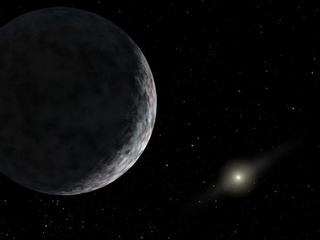
Scientists Claim Discovery of 10th Planet
By ALICIA CHANG, AP Science Writer
LOS ANGELES - It's icy, rocky and bigger than Pluto. And according to scientists who found it orbiting the sun, it's the newest planet on our solar system's block. The planet - the farthest-known object in the solar system - is currently 9 billion miles away from the sun, or about three times Pluto's current distance from the sun.
"This is the first object to be confirmed to be larger than Pluto in the outer solar system," Michael Brown, a planetary scientist at the California Institute of Technology, said Friday in a telephone briefing announcing the discovery.
Brown labeled the object as a 10th planet, but there are scientists who dispute the classification of Pluto as such.
Astronomers do not know the new planet's exact size, but its brightness shows that it is at least as large as Pluto and could be up to 1 1/2 times bigger. The research was funded by NASA.
Brown has submitted a name for the new planet to the International Astronomical Union, which has yet to act on the proposal, but he did not release the proposed name Friday.
The briefing was hastily arranged after Brown received word that a secure Web site containing the discovery was hacked and the hacker threatened to release the information.
Brown and colleagues Chad Trujillo of the Gemini Observatory and David Rabinowitz of Yale University first photographed the object in 2003 using a 48-inch telescope at the Palomar Observatory.
But it was so far away that its motion was not detected until data was analyzed again this past January. It will take at least six months before astronomers can determine its exact size.
It has taken scientists this long to find the planet because its orbit is at an angle compared to the orbits of most planets. The new planet is rocky and icy, similar to Pluto, Brown said.
Alan Stern of the Southwestern Research Institute in Boulder, Colo., said he was not surprised by the discovery since other objects around the size of Pluto have been found in the Kuiper belt, a disc of icy debris beyond the orbit of Neptune.
What's unique about the latest finding is that the object appears to be bigger than Pluto, he said.
"Unless they've made a grave mistake, this is for real," said Stern, who had no role in the discovery.
Planet image:
www.nasa.gov/vision/universe/solarsystem/newplanet-072905-images.html
Samuel Oschin Telescope: www.astro.caltech.edu/palomarnew/sot.html
No comments:
Post a Comment